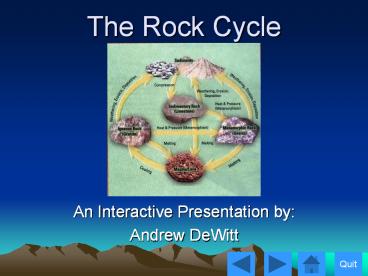The Rock Cycle - PowerPoint PPT Presentation
Title:
The Rock Cycle
Description:
An Interactive Presentation by: Andrew DeWitt Quit The Rock Cycle The Rock Cycle Home Page Overview of Rock Cycle Igneous Rocks Sedimentary Rocks Metamorphic Rocks ... – PowerPoint PPT presentation
Number of Views:172
Avg rating:3.0/5.0
Title: The Rock Cycle
1
The Rock Cycle
- An Interactive Presentation by
- Andrew DeWitt
Quit
2
The Rock Cycle Home Page
- Overview of Rock Cycle
- Igneous Rocks
- Sedimentary Rocks
- Metamorphic Rocks
- Resources
- Concept Map
Quit
3
Overview of the Rock Cycle
- The rock cycle describes Earths natural process
of recycling rocks and sediments. All the rocks
on Earth fall into the three distinct categories
of sedimentary, igneous, or metamorphic rocks.
The names of these rock types refer to the way
the rocks were formed.
Quit
4
Igneous Rocks
- Igneous rocks are formed from magma, the molten
form of Earths mantle layer. These rocks can
form above ground when lava comes out of a
volcano, or they may form under the Earths
surface when magma cools. When igneous rocks are
broken down chemically and physically the pieces
of this rock may be lithified creating
sedimentary rock. Or, if these rocks undergo
heat and pressure they may turn into metamorphic
rock.
Granite is a common igneous rock that is formed
under the Earths surface. About 75 of the
Earths crust is granite.
Click here for examples of igneous rocks
Quit
5
Sedimentary Rocks
- Sedimentary rocks form from weathered pieces of
other rocks (metamorphic, igneous, or other
sedimentary rocks) or from weathered shells of
sea creatures. Also, sedimentary rocks can be
precipitated directly out of water as is the case
with limestone. Coal is also an example of a
sedimentary rock. Coal forms when dead organic
matter is squeezed together before the material
can be decayed. Whatever the case, these rocks
must be squeezed and cemented together.
Quit
Click here for examples of sedimentary rocks
6
Metamorphic Rocks
- Metamorphic rocks form under intense heat and
pressure. These rocks may start out as igneous,
sedimentary or another type of metamorphic rock,
but due to heat and pressure the characteristics
change, generating a metamorphic rock. It is
important to know that rocks continue to change
form. What was once a sedimentary rock may
become a metamorphic rock when subjected to
extreme heat and pressure. With sufficient time
and weathering, that metamorphic rock can become
a sedimentary rock once again.
Evidence of deformation and stress is often
associated with metamorphic rocks due to the fact
that they were subject to extreme heat and
pressure.
Quit
Click here for examples of metamorphic rocks
7
Resources
- Photos from the following siteshttp//evolution.
itgo.com/rock_cycle/cycle.htmlwww.rocksandmineral
s4u.com/rock_cycle.htmlwww.geol.umd.edu/.../GEOL3
88/lectures/02.htmlgeology.com/rocks/igneous-rock
s.shtml - Video from United Streaminghttp//streaming.disc
overyeducation.com/index.cfm
Quit
8
Examples of Igneous Rocks
Rocks formed as lava cooling on Earths surface
Rocks formed as magma cooling under the Earths
surface
Basalt
Gabbro
Diorite
Rhyolite
Obsidian
Granite
Click to go back to igneous rocks information
Quit
9
Examples of Sedimentary Rocks
Click to go back to sedimentary rocks information
Quit
10
Examples of Metamorphic Rocks
Increasing metamorphic grade (more heat and
pressure) from lower left to upper right.
Schist
Gneiss
Slate
Phyllite
Quit
Click to go back to metamorphic rocks information
11
Concept Map
Quit































